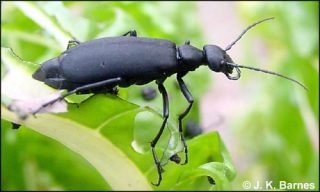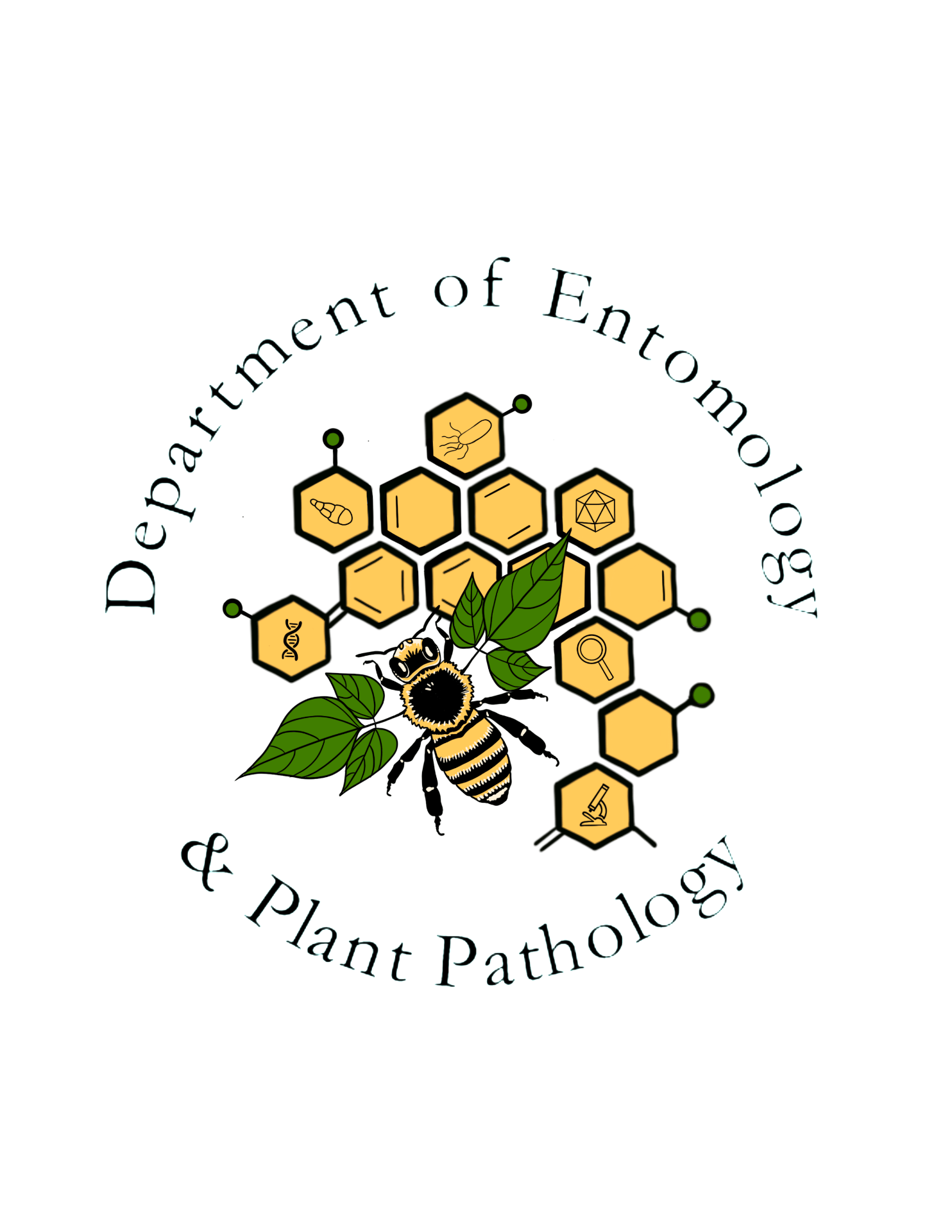Ebony blister beetle
Order: Coleoptera
Family: Meloidae
Genus and species: Epicauta funebris Horn
Species of the family Meloidae are known as blister beetles. They produce a substance called cantharidin, which can cause blistering of skin and mucous membranes and irritation to the digestive and urinary tract. It is also reputed to possess aphrodisiac properties for humans as the active compound in Spanish fly. Larvae of the genus Epicauta are considered beneficial because they impact grasshopper populations, but adults can damage crop, and the cantharidin they contain is toxic to vertebrates, especially horses. Several species feed on alfalfa, so there is a danger of beetles contaminating hay that is fed to domesticated animals.
contaminating hay that is fed to domesticated animals.
Blister beetles feed on leaves, stems, or flowers of a wide variety of plants. Larvae of most genera develop on larvae and provisions of wild bees, but those of Epicauta species consume grasshopper eggs. In the generalized life cycle, there are four distinct types of larval instars: triungulin, first grub, coarctate, and second grub. The first instar triungulin is highly active and searches for subterranean grasshopper eggs. After feeding, the triungulin molts into the first of four feeding instars known as first grubs. Depending on environmental conditions, the fifth instar, or fourth first grub stage, either molts directly to the pupal stage or to an overwintering, diapausing larva known as a coarctate. The coarctate is immobile and strongly sclerotized, and it has reduced mouthparts, legs, and musculature. It is followed by a non-feeding seventh instar, known as the second grub, which is superficially similar to the first grub stages. The second grub is followed by a pupal stage, and then the adult. Adults emerge from the soil, find their host plants, and mate.
Adult female ebony blister beetles lay eggs during the time when differential grasshoppers are producing their egg pods, from late summer until frost. Individuals may lay as many as 300 eggs in narrow, tubular cavities dug about an inch into the soil, then fill the cavities with the excavated soil. Eggs hatch in about a month at room temperature. The triungulins emerge from the soil and search for grasshopper egg masses. They can survive for up to three weeks without food. The triungulin enters the egg mass and begins feeding. Most larval feeding takes place during the autumn and winter months. The larva becomes a fat grub, which burrows deeper into the soil and forms and elongate chamber. There it molts into a quiescent coarctate larva. Coarctate larvae are present in the field from late autumn until late spring, and pupae are present from late spring to late summer.
All larval instars and both sexes of Epicauta funebris produce cantharidin. The first five larval stages accumulate cantharidin as they feed and grow. They exude the substance in a milky oral fluid when disturbed. Only males continue to produce the compound in the adult stage. Adult males transfer cantharidin to adult females in spermatophores during mating. Adult beetles usually respond to disturbance by feigning death and bleeding cantharidin-laden hemolymph from certain leg joints.

The ebony blister beetle is among the most pestiferous species of Epicauta. Although the larvae consume of eggs of the differential grasshopper (Melanoplus differentialis) and perhaps some other pest species, the adults are sporadic pests of garden, truck, and field crops in Arkansas, and they have been known to defoliate tomatoes and swiss chard here. Other hosts include Irish potatoes and clematis, plus some wild plants. Two similar species, the black blister beetle, E. pensylvanica (De Geer), and the clematis blister beetle, E. cinerea (Förster), both have seasonal histories similar to that of the ebony blister. Black blister beetles feed destructively on flowers of goldenrod and other Asteraceae, consuming anthers, stigmas, and other soft flower parts. The clematis blister beetle, as the name implies, prefers clematis, but it will also feed on a number of wild plants in Arkansas.
Epicauta funebris and E. cinerea are broadly sympatric throughout eastern North America, each with three color forms: black, cinereous, and margined. The margined form predominates from the Mississippi River east to New England and Florida. The cinereous form occurs from southern Kansas and Missouri to Nebraska and Iowa. The black form of E. funebris occurs in the Southwest, primarily from Texas and eastern Louisiana north to southern Kansas. E. funebris is easily separated from E. cinerea by the enlarged maxillary palp and the form of the antenna (Pinto 1991). The black form of E. funebris can also be confused with E. pensylvanica, but in E. funebris the third segment of the maxillary palp is longer than the width of the eye. In E. pensylvanica it is shorter than the width of the eye.
